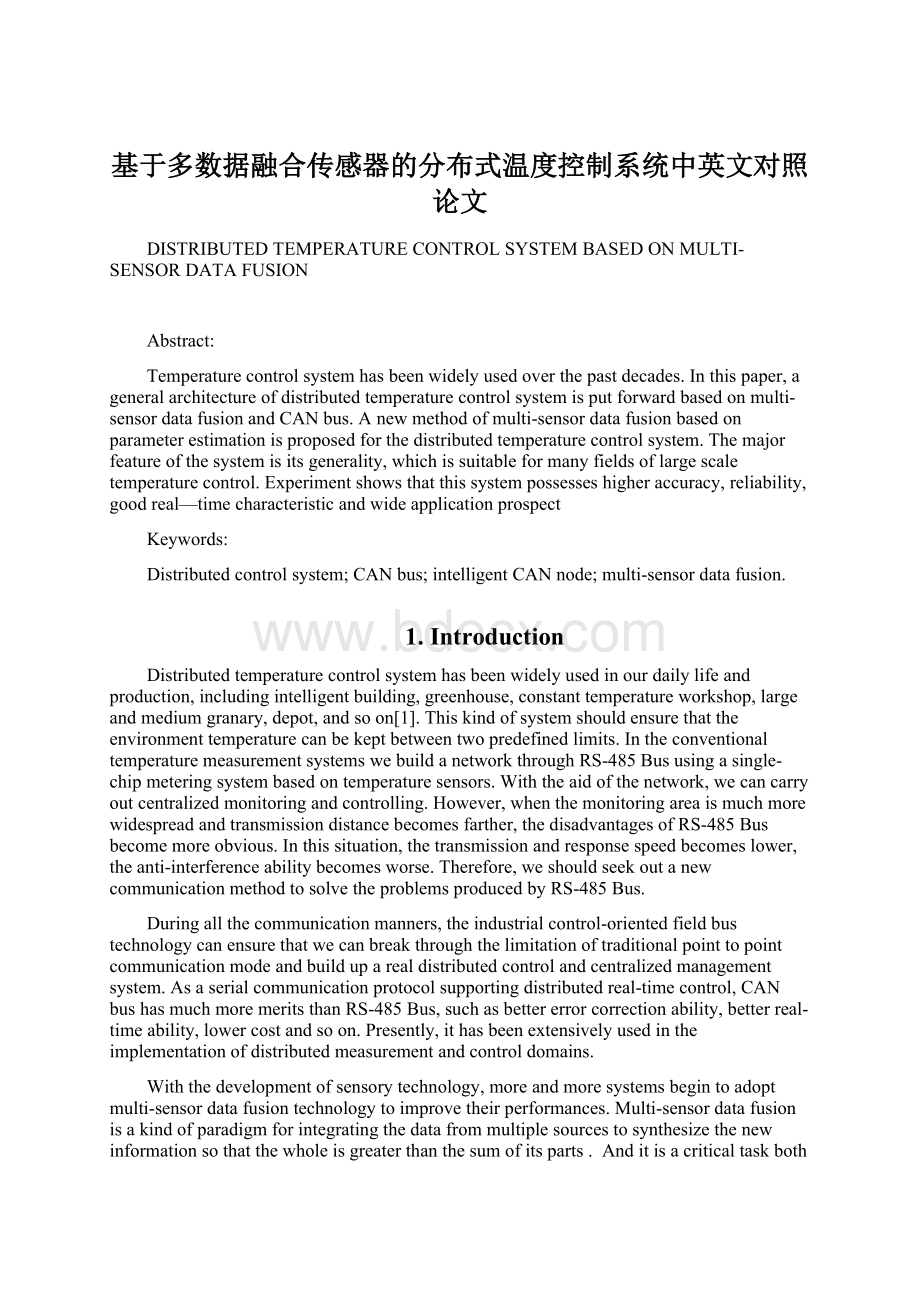基于多数据融合传感器的分布式温度控制系统中英文对照论文.docx
《基于多数据融合传感器的分布式温度控制系统中英文对照论文.docx》由会员分享,可在线阅读,更多相关《基于多数据融合传感器的分布式温度控制系统中英文对照论文.docx(8页珍藏版)》请在冰豆网上搜索。

基于多数据融合传感器的分布式温度控制系统中英文对照论文
DISTRIBUTEDTEMPERATURECONTROLSYSTEMBASEDONMULTI-SENSORDATAFUSION
Abstract:
Temperaturecontrolsystemhasbeenwidelyusedoverthepastdecades.Inthispaper,ageneralarchitectureofdistributedtemperaturecontrolsystemisputforwardbasedonmulti-sensordatafusionandCANbus.Anewmethodofmulti-sensordatafusionbasedonparameterestimationisproposedforthedistributedtemperaturecontrolsystem.Themajorfeatureofthesystemisitsgenerality,whichissuitableformanyfieldsoflargescaletemperaturecontrol.Experimentshowsthatthissystempossesseshigheraccuracy,reliability,goodreal—timecharacteristicandwideapplicationprospect
Keywords:
Distributedcontrolsystem;CANbus;intelligentCANnode;multi-sensordatafusion.
1.Introduction
Distributedtemperaturecontrolsystemhasbeenwidelyusedinourdailylifeandproduction,includingintelligentbuilding,greenhouse,constanttemperatureworkshop,largeandmediumgranary,depot,andsoon[1].Thiskindofsystemshouldensurethattheenvironmenttemperaturecanbekeptbetweentwopredefinedlimits.IntheconventionaltemperaturemeasurementsystemswebuildanetworkthroughRS-485Bususingasingle-chipmeteringsystembasedontemperaturesensors.Withtheaidofthenetwork,wecancarryoutcentralizedmonitoringandcontrolling.However,whenthemonitoringareaismuchmorewidespreadandtransmissiondistancebecomesfarther,thedisadvantagesofRS-485Busbecomemoreobvious.Inthissituation,thetransmissionandresponsespeedbecomeslower,theanti-interferenceabilitybecomesworse.Therefore,weshouldseekoutanewcommunicationmethodtosolvetheproblemsproducedbyRS-485Bus.
Duringallthecommunicationmanners,theindustrialcontrol-orientedfieldbustechnologycanensurethatwecanbreakthroughthelimitationoftraditionalpointtopointcommunicationmodeandbuilduparealdistributedcontrolandcentralizedmanagementsystem.Asaserialcommunicationprotocolsupportingdistributedreal-timecontrol,CANbushasmuchmoremeritsthanRS-485Bus,suchasbettererrorcorrectionability,betterreal-timeability,lowercostandsoon.Presently,ithasbeenextensivelyusedintheimplementationofdistributedmeasurementandcontroldomains.
Withthedevelopmentofsensorytechnology,moreandmoresystemsbegintoadoptmulti-sensordatafusiontechnologytoimprovetheirperformances.Multi-sensordatafusionisakindofparadigmforintegratingthedatafrommultiplesourcestosynthesizethenewinformationsothatthewholeisgreaterthanthesumofitsparts.Anditisacriticaltaskbothinthecontemporaryandfuturesystemswhichhavedistributednetworksoflow-cost,resource-constrainedsensors
2.Distributedarchitectureofthetemperaturecontrolsystem
ThedistributedarchitectureofthetemperaturecontrolsystemisdepictedintheFigure1.Ascanbeseen,thesystemconsistsoftwomodules—severalintelligentCANnodesandamaincontroller.TheyareinterconnectedwitheachotherthroughCANbus.Eachmoduleperformsitspartintothedistributedarchitecture.Thefollowingisabriefdescriptionofeachmoduleinthearchitecture.
3.1maincontroller
Asthesystem’smaincontroller,thehostPCcancommunicatewiththeintelligentCANnodes.Itisdevotedtosuperviseandcontrolthewholesystem,suchassystemconfiguration,displayingrunningcondition,parameterinitializationandharmonizingtherelationshipsbetweeneachpart.What’smore,wecanprintorstorethesystem’shistorytemperaturedata,whichisveryusefulfortheanalysisofthesystemperformance
3.2.IntelligentCANnode
EachintelligentCANnodeofthetemperaturecontrolsystemincludesfiveunits:
MCU—asinglechip,A/Dconversionunit,temperaturemonitoringunit—sensorgroup,digitaldisplayunitandactuators—acoolingunitandaheatingunit.TheoperatingprincipleoftheintelligentCANnodeisdescribedasfollows.
Inthepracticalapplication,wedividetheregionofthecontrolobjectiveintomanycells,andlaytheintelligentCANnodesinsomeofthetypicalcells.Ineachnode,MCUcollectstemperaturedatafromthetemperaturemeasurementsensorgroupswiththeaidoftheA/Dconversionunit.Simultaneously,itperformsbasicdatafusionalgorithmstoobtainafusionvaluewhichismoreclosetotherealone.Andthedigitaldisplayunitdisplaysthefusingresultofthenodetimely,sowecanunderstandtheenvironmenttemperatureineverycontrolcellseparately.
Bycomparingthefusionvaluewiththesetonebythemaincontroller,theintelligentCANnodecanimplementthedegenerativefeedbackcontrolofeachcellthroughenablingthecorrespondingheatingorcoolingdevices.IfthefusionresultisbiggerthanthesetvalueinthespecialintelligentCANnode,thecoolingunitwillbegintowork.Onthecontrary,ifthefusionresultislessthanthesetvalueinthenodetheheatingunitwillbegintowork.Bythismeanswecannotonlymonitortheenvironmenttemperature,butalsocanmakethecorrespondingactuatorworksoastoregulatethetemperatureautomatically.AtthesametimeeveryCANnodeisabletosenddataframetotheCANbuswhichwillnotifythemaincontrollerthetemperaturevalueinthecellsothatcontrollercanconvenientlymakedecisionstomodifytheparameterornot.SincetheCANnodescanregulatethetemperatureofthecellwheretheyare,thetemperatureinthewholeroomwillbekepthomogeneous.What’smore,wecanalsocontroltheintelligentnodebymodifyingthetemperature’ssettingvalueonthehostPC.
Generally,theprocessorsonthespotarenotgoodatcomplexdataprocessinganddatafusing,soitbecomesverycriticalhowtochooseasuitabledatafusionalgorithmforthesystem.Intheposteriorsection,wewillintroduceadatafusionmethodwhichissuitablefortheintelligentCANnodes。
4.Multi-sensordatafusion
Theaimtousedatafusioninthedistributedtemperaturecontrolsystemistoeliminatetheuncertainty,gainamorepreciseandreliablevaluethanthearithmeticalmeanofthemeasureddatafromfinitesensors.Furthermore,whensomeofthesensorsbecomeinvalidinthetemperaturesensorgroups,theintelligentCANnodecanstillobtaintheaccuratetemperaturevaluebyfusingtheinformationfromtheothervalidsensors.
4.1.Consistencyverificationofthemeasureddata
Duringtheprocessoftemperaturemeasurementinourdesigneddistributedtemperaturecontrolsystem,measurementerrorcomesintobeinginevitablybecauseoftheinfluenceoftheparoxysmaldisturbortheequipmentfault.Soweshouldeliminatethecarelessmistakebeforedatafusion.
Wecaneliminatethemeasurementerrorsbyusingscatterdiagrammethodinthesystemequippedwithlittleamountofsensors.Parameterstorepresentthedatadistributionstructureincludemedian—TM,upperquartilenumber—Fv,lowerquartilenumber—FLandquartiledispersion—dF.
Itissupposedthateachsensorinthetemperaturecontrolsystemproceedstemperaturemeasurementindependently.Inthesystem,thereareeightsensorsineachtemperaturesensorgroupoftheintelligentCANnode.SowecanobtaineighttemperaturevaluesineachCANnodeatthesametime.Wearrangethecollectedtemperaturedatainasequencefromsmalltolarge:
T1,T2,…,T8
Inthesequence,T1isthelimitinferiorandT8isthelimitsuperior.
Wedefinethemedian—TMas:
(1)
Theupperquartile—Fvisthemedianoftheinterval[TM,T8].Thelowerquartilenumber—FListhemedianoftheinterval[T1,TM].Thedispersionofthequartileis:
(2)
WesupposethatthedataisanaberrationoneifthedistancefromthemedianisgreaterthanadF,thatis,theestimationintervalofinvaliddatais:
(3)
Intheformula,aisaconstant,whichisdependentonthesystemmeasurementerror,commonlyitsvalueistobe0.5,1.0,2.0andsoon.
Therestvaluesinthemeasurementcolumnareconsideredastobethevalidoneswithconsistency.AndtheSingle-ChipintheintelligentCANnodewillfusetheconsistentmeasurementvaluetoobtainafusionresult
5.Temperaturemeasurementdatafusionexperiment
Byapplyingthedistributedtemperaturecontrolsystemtoagreenhouse,weobtainanarrayofeighttemperaturevaluesfromeightsensorsasfollows
Themeanvalueoftheeightmeasurementtemperatureresultis
Comparingthemeanvalue(8)Twiththetruetemperaturevalueinthecellofthegreenhouse,wecanknowthatthemeasurementerroris+0.5℃.Afterweeliminatethecarelesserrorfromthefifthsensorusingthemethodintroducedbefore,wecanobtainthemeanvalueoftherestsevendata(7)T=29.6℃,themeasurementerroris-0.4℃.
ThesevenrestconsistentsensorcanbedividedintotwogroupswithsensorS1,S3,S7inthefirstgroupandsensorS2,S4,S6,S8inthesecondone.Thearithmeticalmeanofthetwogroupsofmeasureddataandthestandarddeviationareasfollowsrespectively:
Accordingtoformula(13),wecaneducethetemperaturefusionvaluewiththesevenmeasuredtemperaturevalue.
Theerrorofthefusiontemperatureresultis-0.3℃.
Itisobviousthatthemeasurementresultfromdatafusionismoreclosetothetruevaluethanthatfromarithmeticalmean.Inthepracticalapplication,themeasuredtemperaturevaluemaybeverydispersiveasthemonitoringareabecomesbigger,datafusionwillimprovethemeasuringprecisionmuchmoreobviously.
6.Conclusions
Thedistributedtemperaturecontrolsystembasedonmulti-sensordatafusionisconstructedthroughCANbus.Ittakesfulladvantageofthecharacteristicsoffieldbuscontrolsystem---FDCS.Dataacquisition,datafusionandsystemcontrollingiscarriedoutintheinte